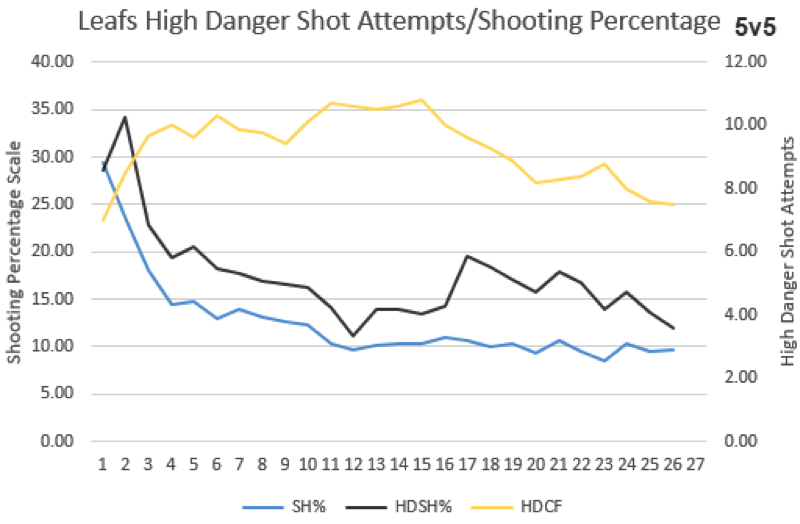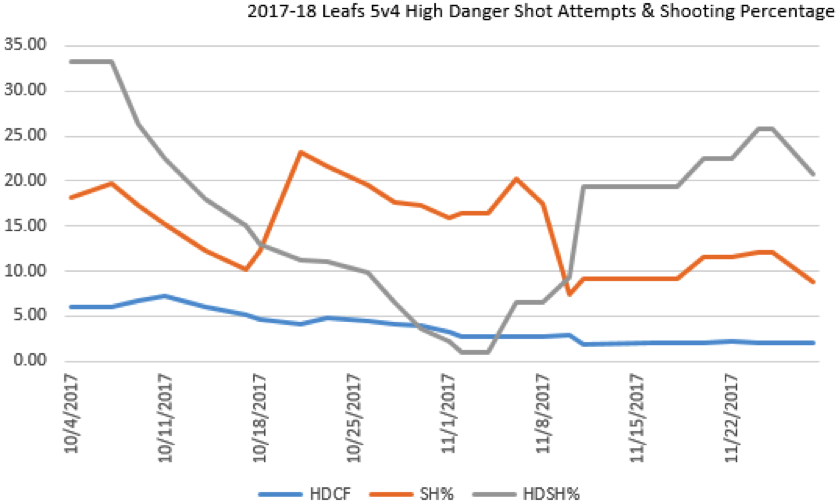It’s an age-old mantra and every hockey coach’s plea: Go to the net and good things happen.
Knowing scoring from in close is a consistent formula for winning games, coaches advocate for players to get to the net with and without the puck.
The goal is to control the dangerous areas in the offensive zone and exploit the better potential for scoring. Scoring chances diminish and scoring becomes much more difficult if the defensive team takes away that dangerous area.
The Toronto Maple Leafs were a beacon for this sentiment at the season’s onset but have shied away from getting into the dirty areas — the high-danger (HD) scoring areas — a little bit recently.
Toronto scored once from a high-danger scoring area in their last game against the Oilers, but that’s not been the general trend as of late.
Before getting into the details, this idea was sparked by an article from James Mirtle of The Athletic that contained a detailed a breakdown of the Leafs success in getting to the dirty scoring areas.
Fortunately, Natural Stat Trick tracks high-danger scoring chances both for and against. The site uses the definition similar to one established by War-On-Ice: The rectangular area that spans the width of the crease and up to the slot area – essentially the point-blank, highly dangerous shooting area.
With that, I went over the Leafs first two months of the season both at even strength (5v5) and power play (5v4). The full table is below.
The explosive scoring from the beginning of the season was clearly unsustainable, but focusing on the bottom of the table at 5v5, the Leafs of late haven’t been getting much scoring success from in-close or from the high-danger scoring areas as pointed out in Mirtle’s piece.
| Game Date | 5v5 HDCF | 5v5 HDCA | 5v5 HDGF | 5v5 HDGA | 5v5 SH% | 5v5 HDSH% | 5v4 HDCF | 5v4 SH% | 5v4 HDSH% |
|---|---|---|---|---|---|---|---|---|---|
| 10/4/2017 | 7 | 8 | 2 | 2 | 29.4 | 28.57 | 6 | 18.2 | 33.33 |
| 10/7/2017 | 10 | 10 | 4 | 1 | 17.9 | 40 | 6 | 21.4 | 33.33 |
| 10/9/2017 | 12 | 3 | 0 | 1 | 7.14 | 0 | 8 | 12.5 | 12.5 |
| 10/11/2017 | 11 | 8 | 1 | 0 | 3.33 | 9.09 | 9 | 9.09 | 11.11 |
| 10/14/2017 | 8 | 8 | 2 | 1 | 15.8 | 25 | 1 | 0 | 0 |
| 10/17/2017 | 14 | 4 | 1 | 0 | 3.85 | 7.14 | 1 | 0 | 0 |
| 10/18/2017 | 7 | 7 | 1 | 1 | 20 | 14.29 | 1 | 25 | 0 |
| 10/21/2017 | 9 | 12 | 1 | 2 | 7.41 | 11.11 | 1 | 100 | 0 |
| 10/23/2017 | 7 | 5 | 1 | 0 | 9.09 | 14.29 | 11 | 9.09 | 9.09 |
| 10/26/2017 | 16 | 12 | 2 | 2 | 9.38 | 12.5 | 0 | 0 | 0 |
| 10/28/2017 | 13 | 6 | 1 | 1 | 9.09 | 7.69 | 4 | 0 | 0 |
| 10/30/2017 | 9 | 11 | 1 | 1 | 11.8 | 11.11 | 0 | 0 | 0 |
| 11/1/2017 | 11 | 3 | 3 | 0 | 12.5 | 27.27 | 1 | 0 | 0 |
| 11/2/2017 | 12 | 6 | 1 | 1 | 4.76 | 8.33 | 4 | 14.3 | 0 |
| 11/4/2017 | 10 | 13 | 2 | 5 | 16 | 20 | 1 | 0 | 0 |
| 11/6/2017 | 6 | 7 | 1 | 1 | 10.5 | 16.67 | 2 | 33.3 | 50 |
| 11/8/2017 | 3 | 10 | 2 | 1 | 16.7 | 66.67 | 0 | 0 | 0 |
| 11/10/2017 | 6 | 14 | 0 | 0 | 0 | 0 | 4 | 10 | 25 |
| 11/11/2017 | 3 | 14 | 0 | 1 | 11.8 | 0 | 1 | 25 | 100 |
| 11/16/2017 | 9 | 5 | 0 | 0 | 0 | 0 | 2 | 0 | 0 |
| 11/18/2017 | 14 | 9 | 4 | 0 | 23.1 | 28.57 | 4 | 0 | 0 |
| 11/20/2017 | 10 | 3 | 0 | 0 | 0 | 0 | 2 | 33.3 | 50 |
| 11/22/2017 | 15 | 4 | 0 | 0 | 2.78 | 0 | 2 | 0 | 0 |
| 11/24/2017 | 4 | 18 | 1 | 2 | 22.2 | 25 | 3 | 20 | 33.33 |
| 11/25/2017 | 6 | 5 | 0 | 0 | 8.33 | 0 | 1 | 0 | 0 |
| 11/28/2017 | 5 | 7 | 0 | 0 | 12.5 | 0 | 2 | 0 | 0 |
| 11/30/2017 | 18 | 12 | 1 | 2 | 8.82 | 5.56 | 0 | 100 | 0 |
In October, the Leafs recorded only one game without a goal from the high-danger scoring area. November didn’t go as well, with seven of their last 10 games featuring no goals from the HD area. Toronto has scored 23 goals at even strength during that span; they have six goals from the HD area in those games, with four coming in the 6-0 drubbing of the Canadiens alone.
Of note, also over the last 10 games, is that they’ve allowed a high-danger goal in only three games (five total goals). Seven games contain zero HD goals against. Toronto may not have had as much in-close success, but they haven’t been giving up any high-danger goals either, despite an uptick in high-danger shot attempts over some select games.
The monthly breakdown is in the table below. The 5v4 HD CF is the average per game, where in October the rate was twice that of November. The deflated overall shooting percentage dip and corresponding HD shooting percentage is reflected in the six goals on the power play over the last 11 games on 26 opportunities (23% efficiency), with two goals coming in the Oilers game.
Note: The tables below were created prior to the final November game against the Oilers.
5v5
| Months | HDCF | HDGF | SH% | HDSH% |
|---|---|---|---|---|
| Oct | 123 | 17 | 12.01% | 15.07% |
| Nov | 114 | 14 | 10.08% | 13.75% |
5v4
| Months | HDCF | SH% | HDSH% |
|---|---|---|---|
| Oct | 4.36 | 17.75% | 9.03% |
| Nov | 2.07 | 9.71 | 18.45 |
The 10-game moving average at even-strength is contained in the chart below. The HD shot attempts (scaled on the right) has dipped from 10 down to the eight range, which may not seem like much but is symptomatic of a greater element that’s manifested itself in the team’s even-strength play. This is something that would require more video input rather than only a simple statistical analysis.
Generating scoring chances isn’t isolated to moving the puck to dangerous areas. East-West passes across the slot line (also known as Royal Road – the imaginary line that follows the crease width up the middle of the defensive zone) force the goaltender to move post-to-post and can catch open seams and holes in the movement. In the event of the return pass, there’s an empty net to shoot at and the high-danger scoring area is less relevant.
The point being, there’s more to scoring than just getting in close and more involved in creating offense off of the rush or off of a cycle. But net-front presence is a crucial component of consistently generating offense. Off the rush, a team can exploit the east-west movement or sharp shoot from the top of the faceoff circle if there’s a lack of space to drive closer. Getting to the dirty area can be more attributable to a play off the cycle, rebounds, and broken plays. There’s a lot to dissect, and that’s out of the scope here, but the links above contain some good background material.

At 5v4, there is a trough for HD shooting percentage at the beginning of November with a volatile rebound inherent to the nature of the power play. The Leafs have two distinct plays with the man advantage. The first is moving East-West with Auston Matthews and William Nylander trading cross-ice feeds for shots on goal. The first goal against Edmonton is the perfect example of that.
The other is a pass with zip into the crease-front with either the net front presence or slot guy tipping it into the open net, as we saw in the example with Patrick Marleau last week.
Last season, the bumper (the slot player in the middle of the 1-3-1) moved down from the slot to the net front and capitalized on the puck getting to the goal via the pass from the goal line or a shot from the outside. Nazem Kadri found great success with this play.
One of the better in tight forwards in the league, James van Riemsdyk has shown the importance of net-front presence and generating offense from the high-danger scoring areas.
Even Morgan Rielly has experienced significant success this season by firing puck in towards the net, where if there’s a rebound or scramble, it’s in the high-danger scoring area, increasing the likelihood of a scoring play. Getting pucks from the outside to the net front allows the chaos to dictate the rest.

There’s no substitute for getting to dirty scoring areas to increase scoring, break slumps, and force teams to scramble. Lately, Toronto has been getting away from that game a little bit, and it’s likely something that’s been brought up by coaching staff. This will be something to monitor as the season progresses.













![John Gruden after the Leafs prospects’ 4-1 win over Montreal: “[Vyacheslav Peksa] looked really comfortable in the net… We wouldn’t have won without him” John Gruden, head coach of the Toronto Marlies](https://mapleleafshotstove.com/wp-content/uploads/2025/09/gruden-post-game-sep-14-218x150.jpg)









![John Gruden after the Leafs prospects’ 4-1 win over Montreal: “[Vyacheslav Peksa] looked really comfortable in the net… We wouldn’t have won without him” John Gruden, head coach of the Toronto Marlies](https://mapleleafshotstove.com/wp-content/uploads/2025/09/gruden-post-game-sep-14-100x70.jpg)







